Breathing Exercises for Sleep, Focus and Success
Jun 20, 2023 by Vreny Blanco · 11 min read · Focus, Wellness

Do you often find it challenging to stay focused? Does procrastination get in the way of your productivity? If so, you’re not alone. Many of us face these challenges daily. Fortunately, there are effective strategies that can help us sharpen our focus and achieve success.
In this blog post, we will explore the relationship between breathing, sleeping, and focus. In addition, we will learn some of the breathing techniques described in Patrick McKeown’s book Atomic Focus (we are not affiliated).
Throughout his book, McKeown explores the relationship between focus, concentration, and success and highlights the critical role that breathing and quality sleep play in this dynamic. McKeown has dedicated over two decades to studying this topic, making him a trusted authority in this field.
Get ready to take control of your mind and unlock your full potential!
Breathing, Sleeping, and Focus
Breathing, sleeping, and focusing are closely connected. Did you know that the way you breathe can affect your overall well-being? Small changes in your breathing pattern, such as fast breathing, can affect essential body functions.
When you breathe fast while asleep, your body interprets it as a sign of danger, causing your brain to wake you up to ensure your safety. Fast breathing during sleep can be caused by poor breathing patterns while awake, such as asthma, anxiety, or hormonal changes. It can also be influenced by high room or body temperature.
So how do you breathe? One way to measure your breathing is to count how many breaths you take per minute while resting or sleeping. You are breathing fast if you take more than 14 breaths per minute in these relaxed states.
To improve your focus, it’s crucial to keep your mind calm, ensure a good night’s sleep, and optimize your breathing. Switching from fast, upper chest breathing to slow, low breathing can be beneficial. In addition, you should breathe through your nose.
Breathing through your nose boosts your brain’s performance by improving your thinking, memory, judgment, and problem-solving skills. It helps your lungs get more oxygen from the air you breathe and helps your body deliver it to your brain. This clears your mind and enhances focus.
Nasal breathing also activates parts of the limbic brain responsible for mental functions like learning, emotions, memory, and motivation. All of which are essential for success.
On the other hand, mouth breathing doesn’t provide any benefits and can contribute to problems like snoring, sleep apnea, and insomnia, especially when combined with fast breathing. If you have trouble falling asleep, make it a habit to breathe through your nose when resting, exercising, and sleeping.
Deep sleep is essential for meeting the demands of daily life. Poor sleep can lead to anxiety, stress, impaired self-awareness, decision-making difficulties, and mood swings.
When the mind is agitated, concentration is affected, and attention span drops.
The BOLT Score
The Body Oxygen Level Test (BOLT) is a way to measure your breathing and your susceptibility to breathlessness.
How to Measure Your BOLT
- Sit down for a few minutes.
- Prepare a stopwatch.
- Exhale normally through your nose.
- Pinch your nose with your fingers and hold your breath.
- Start the stopwatch and time how long it takes you to feel the first urge to breathe in. This time in seconds is your BOLT score.
- Release your nose.
- Resume normal breathing.
Tips for Measuring Your BOLT
- Take it first thing in the morning.
- Measure your value and write down the result.
- Don’t continue to hold your breath beyond your first definite desire to breathe.
Results
- BOLT score more than 25 seconds: Functional, regular breathing.
- BOLT score less than 25 seconds: Your breathing could be improved.
- BOLT score 20 seconds or less: Your score is low, indicating faster, upper chest breathing. This can negatively affect sleep quality, exercise performance, and your state of mind.
The goal is to reach a BOLT score above 25 seconds.
Breathing Exercises
Try to be aware of your breath whenever you can. Observe your breath and bring awareness to your body. Spend a few moments each day doing this.
Before we begin, please keep in mind the following precautions regarding the exercises:
- Not suitable if you are pregnant.
- Exercises involving breath-holding to create moderate to strong air hunger (the feeling of wanting to take in more air) are not recommended if you have any serious medical conditions.
- If you suffer from anxiety, panic disorder, or depression, be careful with all breathing exercises.
- Exercises involving holding your breath to create a moderate-to-strong air hunger are only suitable if you are relatively young, fit, and healthy.
- Take a break if you feel stressed or uncomfortable while doing these exercises.
Breathe Light
Benefits
- Increased blood flow and oxygen delivery to your brain.
- Improved brain function.
- Improved sleep quality.
- Increased BOLT score
- Stimulation of the vagus nerve (The vagus nerve controls essential bodily functions like digestion, heart rate, and breathing).
- Relaxation of body and mind.
- More energy.
- Better attention span.
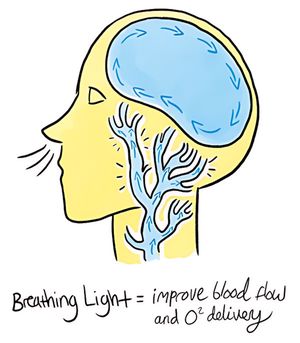
Exercise
- Place your index finger under your nose.
- Concentrate on feeling the airflow over your finger.
- Breathe in gently through your nose.
- Gently slow down the rate of your breathing.
- You should hardly feel any air blowing onto your finger when you exhale.
- Keep your shoulders and stomach relaxed.
Practice for four minutes. If you feel stressed, take a break for 30 seconds. During this exercise, you should feel air hunger.
The purpose is to breathe less air into your body. To do this, inhale gently and quietly and exhale slowly and relax.
By breathing less air periodically throughout the day, you can optimize oxygen flow to your brain. It will also help improve your sleep quality and performance during physical exercise. You will also have more energy and a better attention span.
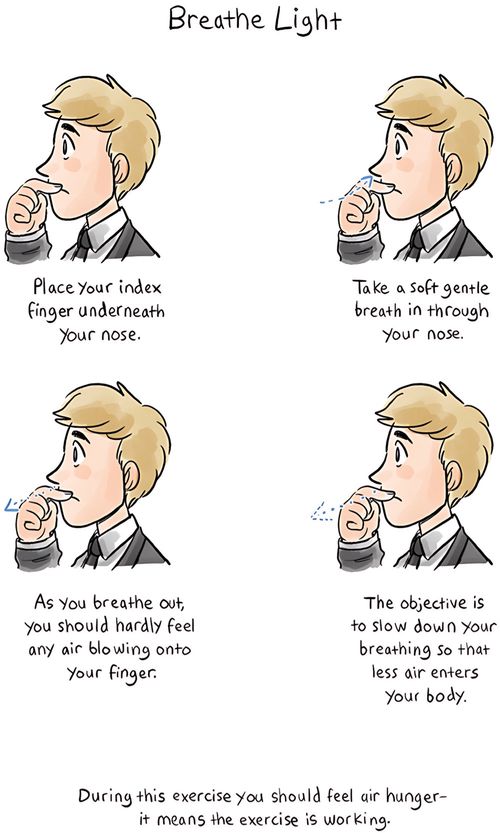
Breathe Slow
By practicing this technique, you can achieve a balance and calm state of mind. It also helps to keep you alert and has a direct impact on how your brain functions.
Engaging in this exercise offers a number of positive effects on your overall well-being, such as:
- Vagus nerve stimulation.
- Improved Heart Rate Variability (HRV is a measure of the variation in time between each heartbeat).
- Optimal recovery.
- Increase your BOLT score
Slow breathing can be used to reverse stress and its negative effects on your ability to make decisions.
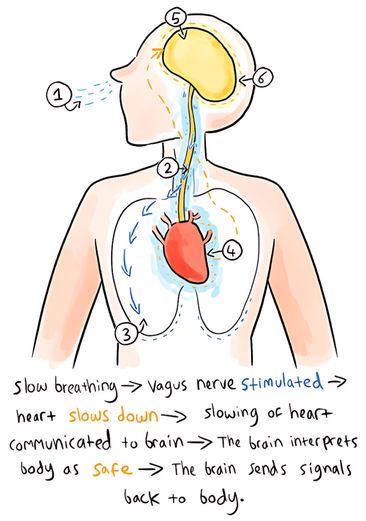
Exercise
- Inhale through your nose for five seconds.
- Exhale through your nose for five seconds.
- Practice for four minutes.
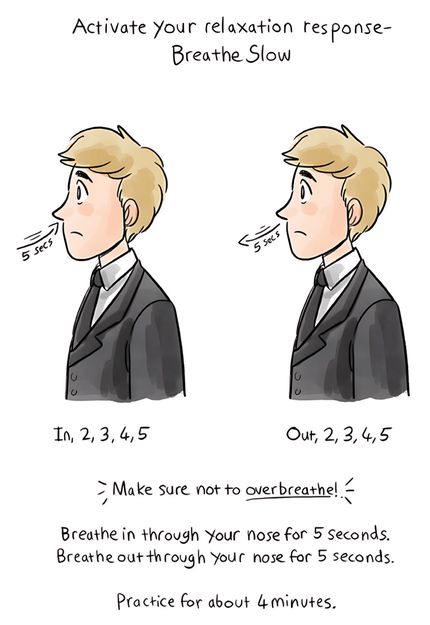
Breathe Deep
Benefits
- Engage your diaphragm (main respiratory muscle).
- Improve your BOLT score
- Improve sleep.
- Achieve an optimal state of mind.
- Improve attention.
- Calm your body and mind.
- Balance emotions.
- Better stress management.
Deep breathing means taking a low breath. This should never be heard during rest or light exercise.
Diaphragmatic breathing enhances your focus and helps you better manage stress. Conversely, chest breathing activates your fight-or-flight response, leading to feelings of agitation, nervousness, and fatigue. This affects your cognitive abilities and emotions.

Exercise
- Lie on your back with your knees bent.
- Place your right palm on your belly and your left palm on your chest.
- Begin to notice your breathing, paying close attention to your abdomen and chest movements.
- Gently breathe with your diaphragm and abdominal muscles.
- As you inhale, your right-hand rises gently as your belly expands. As you exhale, let your right hand gently fall as your belly flattens. However, you should feel little movement under your left palm as it rests on your chest.
- Breathe silently.
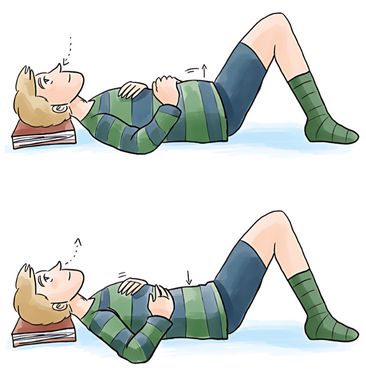
Get in the Zone
Only suitable if you are relatively young, fit, and in good health.
Imagine doing an exercise that mimics the effects your body experiences at high altitudes. This exercise helps open your airways, leading to increased alertness and a sharper mental state. In addition, it will help you stop repetitive thoughts, benefiting your focus.
Warm-Up
- Exhale through your nose.
- Pinch your nose with your fingers to hold your breath.
- Walk 10-15 steps, holding your breath.
- Rest for 30 seconds.
- Repeat twice.
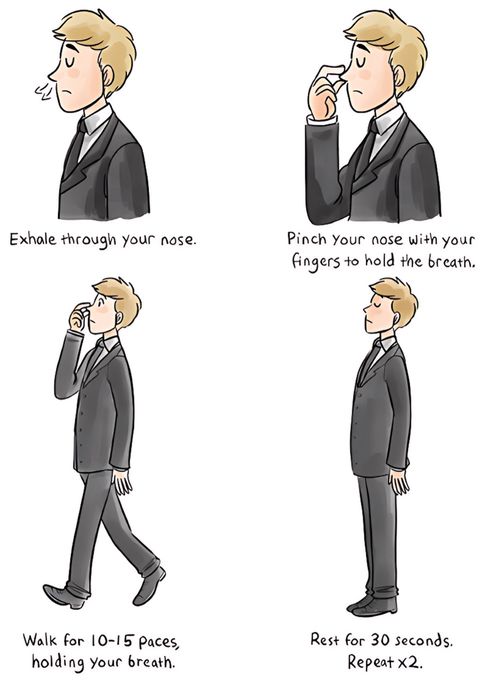
Exercise
- Exhale through your nose.
- Pinch your nose with your fingers to hold your breath.
- While holding your breath, walk or jog until you feel a strong air hunger.
- Release your nose and breathe in through it. Make sure you catch your breath within two breaths.
- Breathe normally for about a minute.
- Repeat five times.
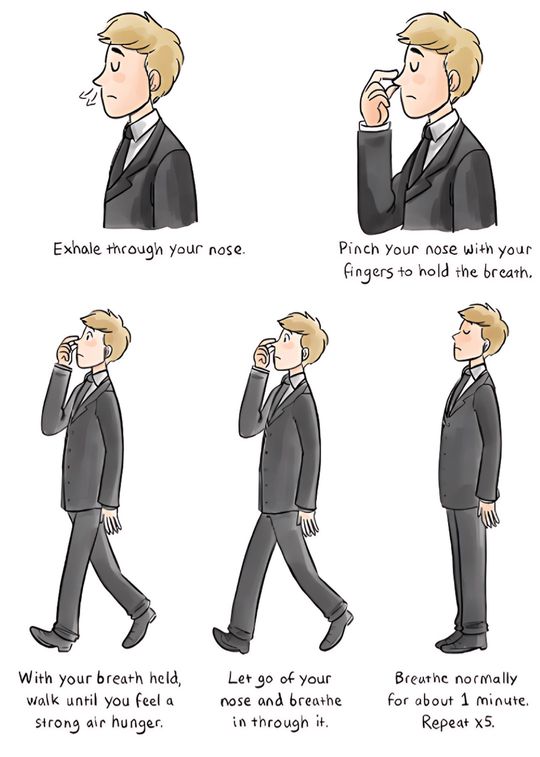
Deep Sleep
Do this exercise before going to bed to help you relax. By practising this technique, you can calm your thoughts and prepare your body for a peaceful night’s sleep.
Exercise
- Sit or lie down comfortably.
- Focus your attention on your breathing.
- Feel the slightly colder air entering your nose and the warm air leaving your nose.
- Begin to slow down the flow of air into your nostrils.
- Breathe in so slowly that you hardly feel any air entering your nose.
- Breathe out softly, slowly and gently through your nose, allowing a relaxed and slow exhalation.
Practice this exercise for 10 minutes before bedtime.
The purpose of this exercise is to intentionally breathe in less air than usual. If you feel the need to take a bigger breath, it means you’re doing it right. But if you start feeling stressed or uncomfortable, it’s crucial to stop. Rest for 15 to 30 seconds and then resume when you’re ready. Listen to your body and take breaks when necessary.
If you suffer from insomnia, it’s important to do the breathing exercises in the evenings. This helps calm your nervous system and reduce your breathing volume.
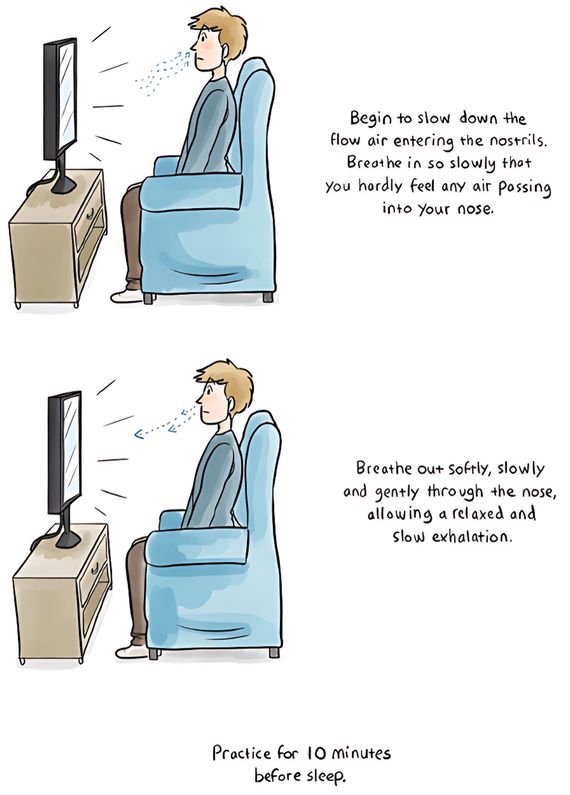
Box Breathing
This exercise is designed to help bring a sense of balance to your mind, allowing you to feel both calm and alert. This simple technique can help you reach a state of peaceful awareness.
Practice this exercise breathing softly in and out through your nose.
Exercise
- Breathe in for four seconds.
- Hold your breath for four seconds.
- Breathe out for four seconds.
- Hold your breath for four seconds.
- Repeat for two to four minutes.
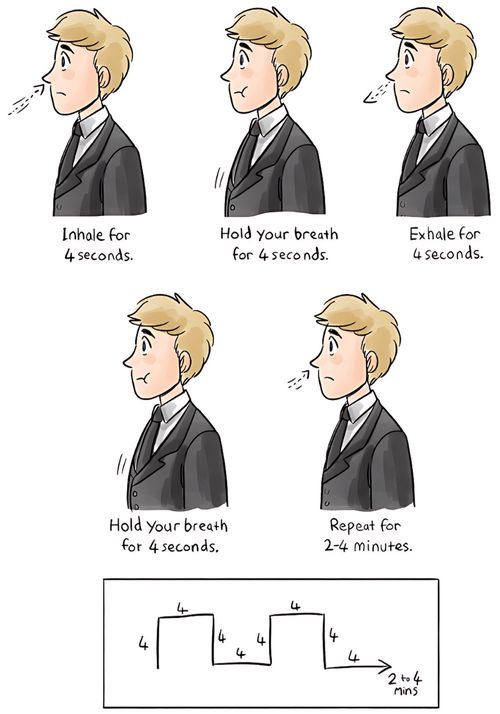
Breathing, Focus, and Success
Your brain needs oxygen to think. If the way you breathe reduces oxygen to your brain, you won’t be able to maintain focused attention.
To get the most oxygen to your body and brain, your breathing should be light, quiet, and through your nose. There will be a natural pause after each exhalation. This will also help you to relax. When your mind is calm, your concentration and attention span increase.
To integrate the exercises into your daily routine, you must learn how to bring your attention out of your mind and into your body. To do this, focus only on the breath:
- The slightly cooler air entering your nose.
- The slightly warmer air coming out of your nose.
- If your mind wanders, bring it back to the breath.
This is training your brain to focus. If you can train your brain to focus on the breath, you can teach it to focus on any task. And remember, focus is the key to success!
Shape Your Environment for Success
Customize your workspace to your individual needs for optimal concentration.
Block Digital Distractions Before Your Breathing Sessions
To avoid interruptions, eliminate digital distractions before you begin your breathing exercises. Put away your phone, turn off notifications, and use an app and website blocker. Using an app and website blocker can significantly reduce your exposure to unwanted content. If you have a Mac, you can block all the online content you don’t need with 1Focus.
- Block websites and apps during working hours and breathing sessions.
- Block all websites except the specific ones you need for work or study, to ensure monotasking.
- Block the internet by blocking the App Store and installed web browsers.
Block Digital Distractions During Your Bedtime
With 1Focus, you can set up a schedule to block all apps and websites at night. This helps you maintain a consistent bedtime and wake-up routine.
Conclusion
Implementing simple yet powerful breathing exercises can improve your brain function, increase your attention span, and promote relaxation.
It may seem strange, but exposing your body to moments of discomfort, such as air hunger, can be beneficial. It helps your body become less sensitive to the feeling of suffocation and strengthens your willpower. You’re teaching your body and mind to relax even in discomfort.
So listen to your body, take breaks when you need to, and trust that with practice, you’ll become more resilient and better able to find a sense of calm in uncomfortable situations.
Remember, practice makes perfect, and as with any exercise, your body needs time to adapt and grow stronger.
By understanding the crucial relationship between breathing, sleeping, and focus, you can harness the power of these elements to achieve success.
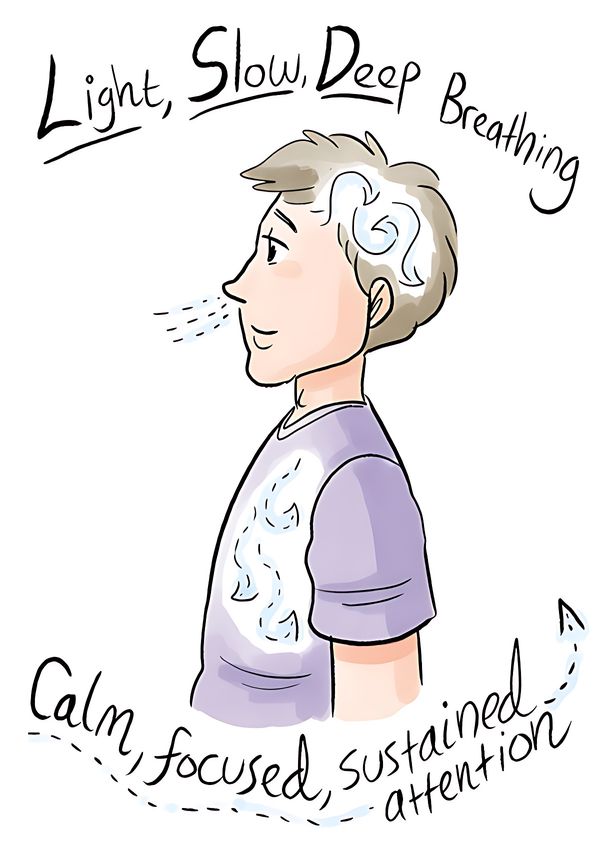
Further Reading
For more insights and tips, explore our Focus and Wellness categories. Discover additional strategies to enhance your concentration, improve your well-being, and achieve your goals.
All content and images in this blog post are sourced from the book Atomic Focus (2021) by Patrick McKeown. If you’d like to learn more about this topic and discover additional exercises, visit Oxygen Advantage®.



